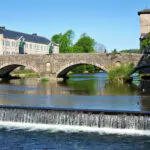Kendal is one of the main gateways to the Lake District. It is situated in the valley of the River Kent and surrounded by hills. This was once the chief town of Westmorland, a county long swallowed up by Cumbria. Kendal was always the meeting point of the various routes between Scotland, Yorkshire and Lancashire and all routes south.
Although Kendal was never an industrial centre in the recognised sense, it has several well-known products including shoes, supplied with leather by the local tanneries, and the Kendal mint cake, produced to supply climbers with an additional source of energy. It was said to have been taken by Sir Edmund Hilary, when he conquered Everest. A former product of the town was its green cloth. This was said to have been the Lincoln green worn by Robin Hood and his Merry Men. The cloth and thus the town are mentioned in Shakespeare’s “Henry IV”. The trade in woollen cloth made the town a wealthy centre in the Middle Ages and the trade reached its height in the 18th Century.
Much of the old medieval town planning is still reflected in the layout of the town today. The main streets had houses and shops at the front whilst behind them, in the numerous alleyways, were workshops and stables. The earliest settlement is believed to have been at Castle How and there was a later Roman outpost at Watercrook.

There is a remnant of an early Saxon cross in the parish church. This church is one of the largest parish churches in England and has five aisles. The architecture is mostly perpendicular and the tower is rather squat in appearance. It contains an interesting collection of memorials and other items. One of the ten bells in the tower is dated 1537. The church contains several family chapels, including one belonging to the Parr family.
Ivo de Taillebois was created Earl of Kendal by William the Conqueror, suggesting that there was already a significant settlement here at that time. Catherine Parr, the last wife of Henry VIII, was born in Kendal Castle and her Book of Devotions is held in Kendal in the Mayor’s Parlour at the Town Hall. Catherine returned to live in the castle after the death of the king. The castle is now in ruins and lies to the east of the town.

There are several very old buildings in Kendal, some of which are open to visitors. Castle Dairy is mainly Tudor but parts of it, including the doorways, date from the 14th Century. Fleece Inn is a 17th Century building with galleries. The Kendal Museum of Archaeology and Natural History has some interesting displays of Neolithic and Roman artefacts. The well-known fell walker and writer, Wainwright, was once curator of the museum.
The market dates from the issue of a charter in 1189, by Richard I. The rights of the charter were purchased by the local corporation in the second half of the 19th Century, making this a free market. Although the market hall has been converted into a permanent shopping centre, there are still traditional stalls outside each Wednesday and Saturday. There is also a monthly farmer’s market.
Kendal Town Hall is a 19th Century listed building containing the Mayor’s Parlour, which is not normally open to the public but holds a wealth of interesting artefacts related to the history of the town. George Romney served his apprenticeship as a portrait painter in Kendal and some of his work can be seen in the Abbot Hall Art Gallery. The largest collection of Romney in the country is held in the main Abbot Hall building, in addition to works by many other well-known English artists.
Not far from Kendal is Levens Hall, an Elizabethan house originally built around a pele tower. The house and gardens are open to the public and these gardens are particularly known for their topiary. These are believed to be the oldest topiary gardens in the world and some of the fantastic shapes can be seen from the road passing the estate.







